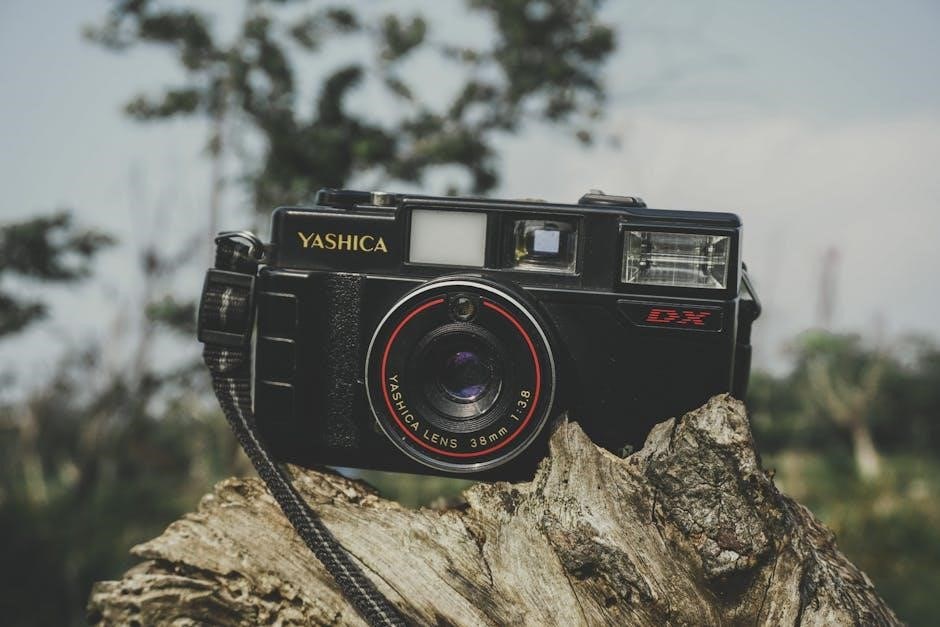
This manual provides comprehensive guidance for the Yashica MAT 124, a twin-lens reflex camera known for its ease of use and creative control, ideal for photographers seeking precise exposures and artistic expression.
Overview of the Yashica MAT 124 Camera
The Yashica MAT 124 is a twin-lens reflex camera designed for medium-format photography, supporting both 120 and 220 film rolls. It features a fixed Yashinon 80mm f/3.5 lens, a built-in CdS exposure meter, and a Copal-SV shutter with speeds from 1 to 1/500 seconds. The camera offers a match-needle system for precise exposures and supports ASA film speeds from 25 to 400. Its intuitive design and robust construction make it a favorite among photographers seeking creative control and high-quality images in various shooting conditions.
Key Features and Benefits
The Yashica MAT 124 offers a twin-lens reflex design with interchangeable 120/220 film capabilities, providing flexibility for photographers. Its 80mm f/3.5 Yashinon lens ensures sharp images, while the Copal-SV shutter delivers precise control with speeds up to 1/500s. The built-in CdS exposure meter simplifies aperture and shutter adjustments using a match-needle system. Supporting ASA film speeds from 25 to 400, this camera is versatile for various lighting conditions. Its durable build and intuitive controls make it a reliable choice for both professional and amateur photographers seeking high-quality medium-format results.
Why the Yashica MAT 124 is Popular Among Photographers
Photographers favor the Yashica MAT 124 for its twin-lens reflex design, offering precise focus and composition control. The camera’s portability and intuitive controls make it ideal for fieldwork. Its interchangeable film formats (120/220) and ASA range (25-400) cater to diverse shooting needs. Additionally, the CdS exposure meter and Copal-SV shutter provide accurate exposures, while the Yashinon 80mm f/3.5 lens delivers sharp, high-quality images. These features, combined with its durability, make the Yashica MAT 124 a beloved tool for both professional and amateur photographers, ensuring exceptional medium-format photography experiences.

Description of the Camera Parts
The Yashica MAT 124 features a twin-lens reflex design with a Yashinon 80mm f/3.5 lens, a built-in CdS exposure meter, and a Copal-SV shutter, alongside a film counter for precise film tracking.
The Twin-Lens Reflex Design
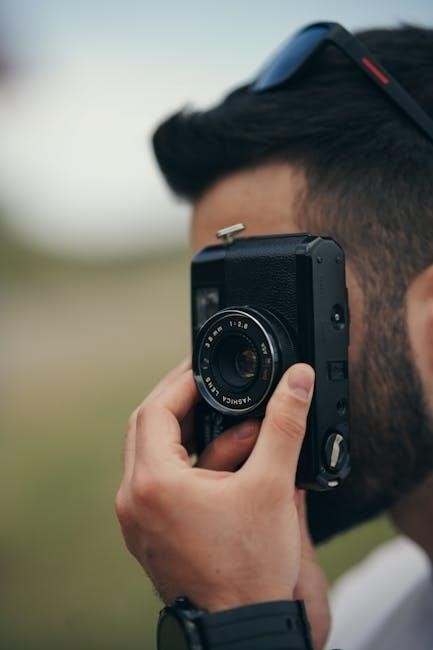
The Yashica MAT 124 employs a twin-lens reflex design, featuring a viewing lens and a taking lens. This setup allows for precise composition and focus, with the viewing lens providing a direct optical view of the scene. The twin-lens design minimizes camera shake and enables quieter operation, as only the taking lens moves during exposure. This classic configuration is favored by medium format photographers for its simplicity and effectiveness in achieving sharp, well-framed images. The design also supports interchangeable waist-level finders for enhanced versatility in shooting styles.
The Yashinon 80mm f/3.5 Lens
The Yashinon 80mm f/3;5 lens on the Yashica MAT 124 is a high-quality, four-element lens designed for optimal optical performance. Its focal length and aperture make it ideal for portraits and landscapes, ensuring sharp images with minimal distortion. The lens’s construction enhances color accuracy and contrast, providing professional-grade results. Its compact design contributes to the camera’s portability, making it easy to handle in various shooting conditions. This lens is a key feature of the MAT 124, offering versatility and reliability for photographers seeking precise control over their imagery.
The Built-in CdS Exposure Meter
The Yashica MAT 124 features a built-in CdS exposure meter, utilizing a match-needle system for precise control. Powered by a 1.3V mercury battery, it offers a film speed range of ASA 25 to 400. The meter is coupled to the shutter speed and aperture settings, ensuring accurate exposures. By aligning the needles, photographers can achieve optimal results effortlessly. This system simplifies the process of adjusting settings, making it user-friendly for both professionals and enthusiasts. The CdS meter is a reliable tool for achieving consistent and high-quality photographs with minimal effort.
The Copal-SV Shutter
The Copal-SV shutter in the Yashica MAT 124 offers a wide range of shutter speeds, from 1/500th of a second to 1 second, plus a Bulb setting for long exposures. This versatility allows photographers to capture a variety of scenes, from freezing fast-moving subjects to creating artistic motion blur. The shutter is known for its reliability and smooth operation, ensuring consistent performance. Its durable construction withstands regular use, making it a dependable component for both casual and professional photography; The Copal-SV shutter is a key feature that enhances the camera’s creative possibilities.
The Film Counter and Exposure System
The Yashica MAT 124 features a reliable film counter and exposure system, supporting both 120 and 220 film formats. The counter automatically adjusts based on the film type, ensuring accurate tracking of exposures. This system prevents double exposures and provides a clear visual indication of remaining shots. The mechanism is designed for seamless operation, allowing photographers to focus on composition and creativity without interruption. The film counter is a practical and essential feature that enhances the shooting experience, making the MAT 124 user-friendly for photographers of all skill levels.
Loading and Unloading Film
Loading and Unloading Film
The Yashica MAT 124 supports both 120 and 220 film formats, with a straightforward loading process that requires adjusting the pressure plate for the selected film type, ensuring proper tension for smooth operation.
How to Load 120 or 220 Film
To load film, open the camera back by sliding the catch. Attach the film to the spool, ensuring it aligns with the guide. For 120 film, set the pressure plate to the lower position, and for 220 film, use the upper position. Gently advance the film until the arrow on the backing paper aligns with the red dot on the camera. Close the back, ensuring it clicks securely. This process ensures proper tension and prepares the camera for shooting with either film format.
Advancing Film and Setting the Counter
After loading the film, turn the advance knob until the number “1” appears in the red window. This ensures proper alignment of the film. Set the film counter to match the number of exposures (12 for 120 film, 24 for 220 film). Always advance the film and cock the shutter before taking the first shot to avoid double exposures. The counter will automatically decrement as you advance the film, ensuring accurate tracking of your exposures throughout the roll.
Setting Up the Camera
Setting up the Yashica MAT 124 involves adjusting the ASA film speed, selecting aperture, and choosing appropriate shutter speeds. Use the match-needle system for precise exposures.
Setting the ASA Film Speed
To set the ASA film speed on the Yashica MAT 124, locate the ASA dial on the camera’s top plate. Rotate the dial to match the film’s speed, ensuring accurate exposures. The camera supports speeds from ASA 25 to 400. A 1.3V mercury battery powers the exposure meter, which simplifies the process. Always set the ASA before loading film for precise metering. Use a light source if needed to ensure the setting aligns with the film’s sensitivity. This step is crucial for achieving optimal results in various lighting conditions. Refer to the manual for specific film recommendations and settings.
Choosing the Aperture and Shutter Speed
Aperture and shutter speed on the Yashica MAT 124 are set manually, offering creative control over exposure. The aperture is adjusted on the lens, ranging from f/3.5 to f/32, while the shutter speed is set on the top plate, with speeds from 1 second to 1/500th of a second, plus B and T modes. The Copal-SV shutter ensures precise mechanical control, functioning without battery power. Use the match-needle system in the viewfinder to balance aperture and shutter speed for optimal exposure. Adjustments are straightforward, allowing photographers to achieve desired effects, such as depth of field or motion capture, with ease.
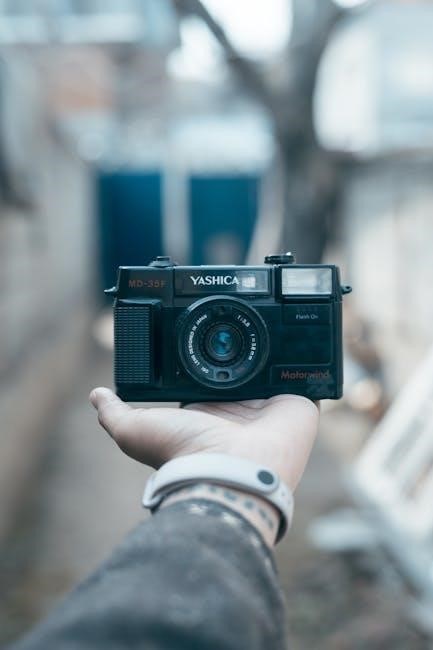
Using the Exposure Meter
The Yashica MAT 124 features a built-in CdS match-needle exposure meter, simplifying accurate exposure settings by aligning the aperture and shutter speed needles in the viewfinder.
Understanding the Match-Needle System
The match-needle system simplifies exposure adjustment by aligning two needles in the viewfinder. One needle indicates the recommended exposure, while the other reflects the camera’s aperture and shutter speed settings. To use this system, photographers select a shutter speed and adjust the aperture until the needles align, ensuring accurate exposures. The CdS meter powers this feature, operating within an ASA range of 25 to 400. This intuitive method eliminates guesswork, making precise exposures achievable for photographers of all skill levels. The meter switch automatically engages when the shutter speed dial is rotated, streamlining the process further.
Synchronizing Shutter Speed and Aperture
Synchronizing shutter speed and aperture is essential for precise exposures. Start by setting the ASA film speed using the dial on the lens. Next, select a shutter speed and adjust the aperture until the match-needle system aligns. The built-in CdS meter guides this process, ensuring optimal exposure. For more control, fine-tune by adjusting either the aperture or shutter speed slightly. Proper synchronization is critical for achieving desired results, whether in bright or low-light conditions. Always refer to the match-needle alignment for accurate exposures, ensuring your images are well-balanced and of high quality.

Flash Photography Basics
Master flash photography with the Yashica MAT 124 using X and M synchronization modes; The X mode is ideal for electronic flashes, while M mode suits F-class bulbs. Ensure the flash is set correctly and the guide number aligns with your setup for optimal results. Proper synchronization enhances your images, especially in low-light conditions, providing well-balanced illumination and creative control.
Using X and M Flash Synchronization Modes
The Yashica MAT 124 offers two flash synchronization modes: X and M. The X mode is designed for electronic flash units, ensuring proper synchronization with faster shutter speeds. The M mode is optimized for F-class flash bulbs, which require a slightly delayed synchronization. To use these modes, switch the Flash Synchronizer Selector to the desired position. Always refer to the guide number on the flash unit to set the correct aperture. Proper synchronization ensures well-balanced flash illumination, enhancing your photography in low-light conditions while maintaining creative control over the exposure.
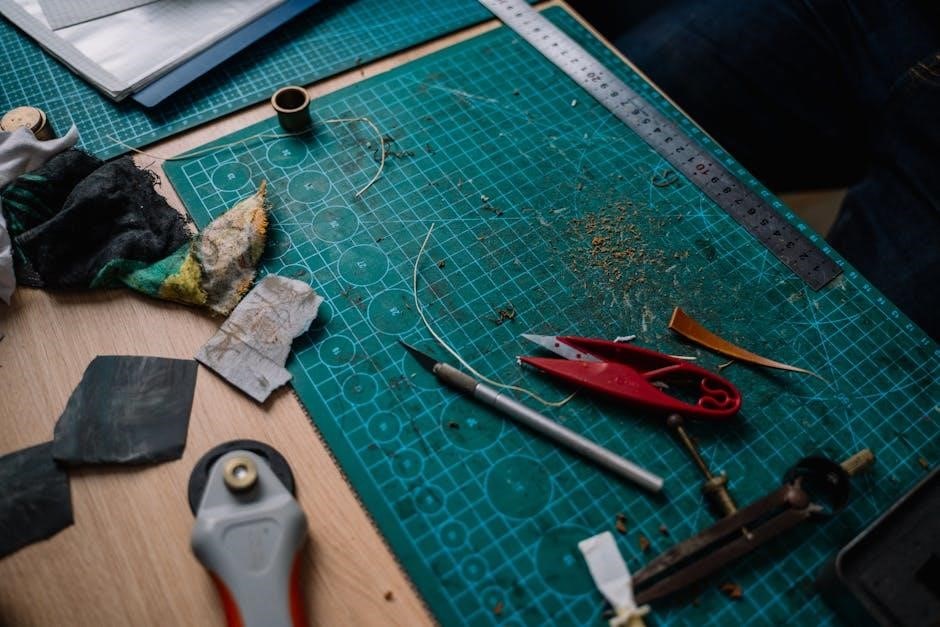
Tips for Maintenance and Troubleshooting
Regularly clean the camera and lenses to prevent dust buildup. Replace the 1.3V mercury battery with equivalents like Mallory PX-138 or Eveready EPX-13. Inspect the Copal-SV shutter curtains for damage and ensure proper synchronization for optimal performance.
Cleaning and Maintaining the Camera
Regularly clean the camera body and lenses with a soft, dry cloth to prevent dust and smudges. Use a lens brush or blower to gently remove debris from the optics. Avoid harsh chemicals or abrasive materials that could damage coatings. For stubborn smudges, dampen a microfiber cloth with distilled water, but avoid touching the lens surface. Ensure the taking lens is free of smudges for sharp images. Store the camera in a dry, cool place to prevent mold and corrosion. Regular maintenance ensures optimal performance and longevity.
Common Issues and Solutions
- Meter accuracy issues: Ensure the built-in CdS meter is functioning correctly. Replace the 1.3V mercury battery if necessary.
- Film loading problems: Always load film in low-light conditions and ensure the film counter aligns properly.
- Sticky shutter curtains: Lubricate the Copal-SV shutter mechanism gently if speeds become inconsistent.
- Light leaks: Inspect and replace worn-out light seals around the film compartment to prevent fogging.

Additional Resources
Access the official PDF manual for detailed instructions. Explore repair options and online resources for troubleshooting. Visit camera manual libraries for comprehensive guides and user support.
Accessing the PDF Manual
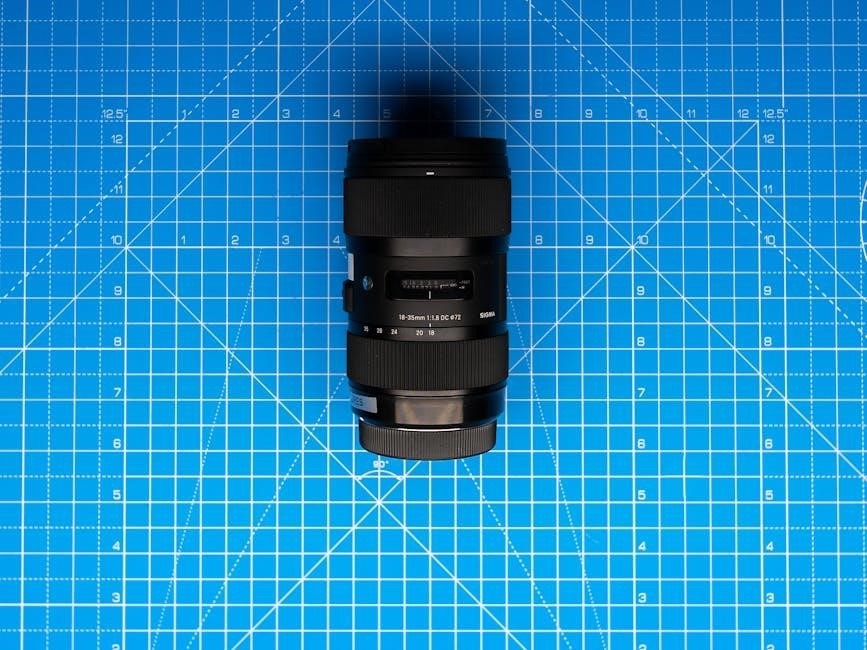
The Yashica MAT 124 manual is available in PDF format online, providing detailed instructions for camera operation, maintenance, and troubleshooting. It covers camera parts, film loading, exposure settings, and flash usage. Users can download the manual from trusted sources like camera manual libraries. The PDF includes diagrams and step-by-step guides, ensuring easy understanding. For convenience, it’s searchable and printable. Donations to platforms like M. Butkus support manual preservation. Accessing the PDF manual is essential for mastering the Yashica MAT 124’s features and optimizing its performance.
Repair and Service Options

For repairs, the Yashica MAT 124 manual recommends consulting authorized service centers or skilled technicians. DIY repairs can be attempted using the provided repair manual, but caution is advised. The camera’s Copal-SV shutter and CdS meter are critical components requiring professional attention. Replacement parts, like the 1.3V mercury battery, are detailed in the manual. Online resources offer repair guides, but ensure they are trusted sources. Regular maintenance can prevent major issues, but when repairs are needed, rely on experts or official documentation to preserve the camera’s functionality and value.